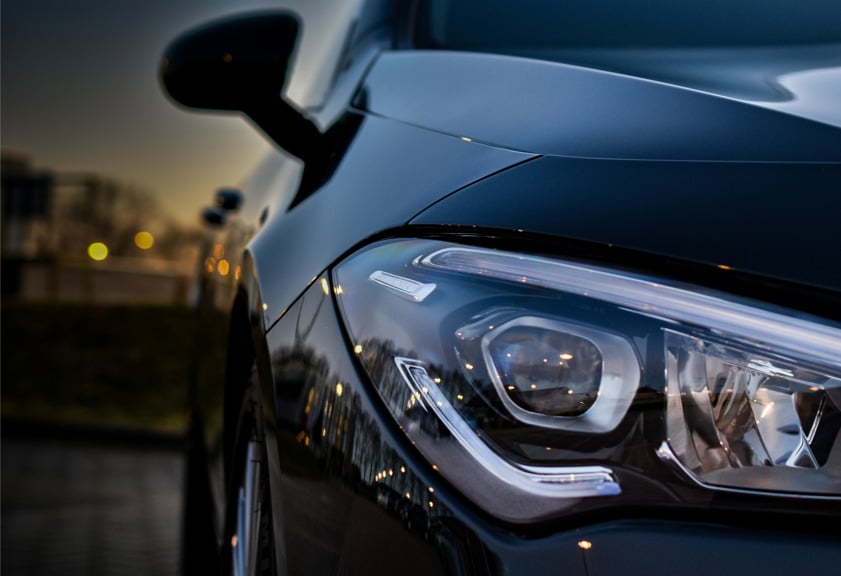
If you've driven at night recently, chances are you've been dazzled by the glare of oncoming headlights. Many UK drivers feel modern headlights have become too intense, to the point where they're not just annoying but genuinely dangerous.
While brighter LEDs and high-intensity beams improve visibility for the driver using them, they can leave everyone else struggling to see the road ahead. This issue has sparked debates, new research, and even upcoming changes to vehicle regulations.
In this blog, we'll explore why headlight glare has become such a hot topic, what causes it, and how it impacts road safety. We’ll also look at the latest innovations in headlight design (many of which are available on new lease cars) so you can see how choosing the right vehicle makes driving safer. We discuss:
Headlight glare is the excessive brightness or dazzling effect caused by oncoming headlights. It temporarily impairs your vision, making it much harder to focus on the road.
This glare is often more pronounced with modern LED and xenon lights, which have a cooler, blue-white colour when compared to the warmer halogen lights of yonder year.
Several factors contribute to headlight glare:
- LED and xenon technology - while efficient and powerful, these lights have a higher intensity that's harsher on the eyes.
- Vehicle height - SUVs and larger vehicles sit higher, so their headlights shine directly into the line of sight of some drivers.
- Improper alignment - poorly adjusted headlights can project light too high and into the eye line of drivers. Older cars with poorly aligned or outdated headlights are more likely to cause glare.
Leasing gives you access to newer models with correctly calibrated lights. Explore our latest deals or contact one of our sales consultants at 0345 811 9595.
For many drivers, the short answer is yes. A survey by the RAC, involving 2,000 drivers, revealed that 89% believe car headlights are excessively bright, with 28% feeling this is true for most car headlights on the road.
The problem isn't just perception. Department for Transport figures show an average of 280 collisions per year where "dazzling headlights" were listed as a contributory factor.
It's that bad in fact, that the Labour government commissioned research into headlight glare back in 2024, with a report expected late-2025 (Road SafetyGB).
The effects of glare can go beyond momentary discomfort:
- Reduced reaction times and increased stopping distances.
- Distort depth perception, making it harder to judge the speed of oncoming vehicles.
- Encourage avoidance behaviour, with some drivers avoiding night time driving altogether.
In extreme cases, some drivers have reported suffering eye pain, fatigue, and headaches after experiencing dazzle on the road.
The Highway Code sets out clear rules on how to use your headlights safely to avoid dazzling other road users:
- Rule 114 - You must not use any lights in a way that dazzles or causes discomfort to other road users, including oncoming drivers, cyclists, pedestrians, and horse riders. Always dip your headlights when there’s a risk of glare.
- Rule 115 - You should also use dipped headlights at night in built-up areas and during dull daytime weather. Dip your main beam when overtaking or when another vehicle is approaching to avoid dazzling them. Only use full beam when there’s no other traffic nearby.
“Most cases of glare are preventable. Simple steps like regular headlamp checks and dipping your beam when required can make night driving safer for everyone.”

Glare from oncoming vehicles can make night time driving stressful, but there are several ways to reduce its impact:
- Adjust your mirrors - Tilt your rear-view mirror to its night setting to reduce glare from vehicles behind. Properly position side mirrors to minimise reflections.
- Clean your windshield - Dirt, smudges, and streaks amplify glare. Clean both the inside and outside regularly.
- Use your car’s visor - It’s not just for daytime use; it can also block glare from tall vehicles or poorly aligned headlights at night.
- Dim your dashboard lights - Bright interior lighting can make glare feel worse. Lower the brightness to help your eyes adjust to the dark.
- Regular eye check-ups - If glare seems to affect you more than others, book an eye test to rule out any underlying issues.
- Use the right eyewear - Glasses with an anti-reflective coating can help cut down glare. Avoid tinted lenses at night as they reduce visibility.
It’s no secret that the brightness of modern headlights has become a real concern for many drivers. But what’s being done to fix the problem?
Car manufacturers are constantly developing new technologies to tackle the problem without compromising visibility. Modern vehicles, particularly those available to lease, are at the forefront of these innovations:
- Adaptive headlight technology - Automatically adjusts the angle, intensity, and direction of the beam depending on your speed, steering, and the presence of other vehicles.
- Matrix LED and laser headlights - Found on many prestige and even mid-range cars, these use multiple LEDs that can switch on and off independently. This allows the beam to be selectively dimmed.
- OLED lights - OLED provides less glaring illumination compared to traditional LEDs. Many new lease cars, especially in the premium segment, are beginning to incorporate OLED technology into their lighting systems.
Leasing a new car means you can enjoy these features sooner, without worrying about the high upfront cost of ownership or outdated tech.
Headlight brightness glare are genuine safety issues that affect thousands of drivers every year. While modern lighting has made roads brighter for those behind the wheel, it has also created new challenges for everyone else.
The good news is that manufacturers are responding with innovative solutions like adaptive headlights, matrix LEDs, and OLED systems that reduce glare.
Choosing a car equipped with these features doesn’t just make your night drives safer, it makes them more enjoyable.
Leasing a new car is the easiest way to get behind the wheel of a car fitted with the latest glare-reducing technology. We offer a wide range of modern lease cars, from practical hatchbacks to prestige SUVs.
Browse our latest lease deals and find your perfect vehicle today.
Originally posted: 14th February 2024
Last updated: 29th July 2025
Due to be reviewed: 1st April 2026

